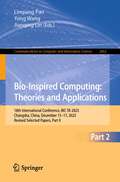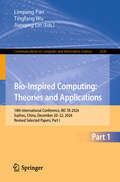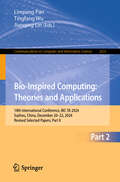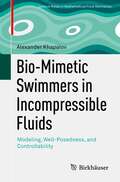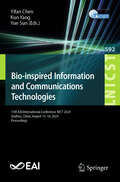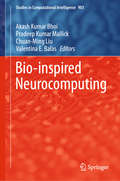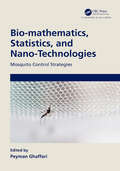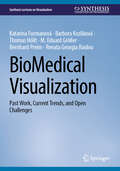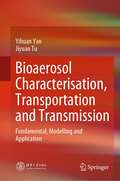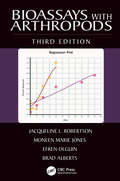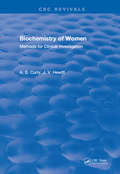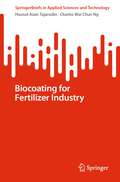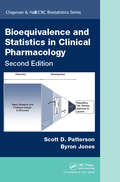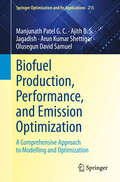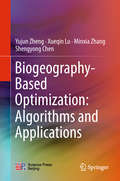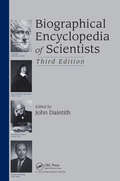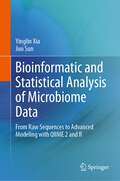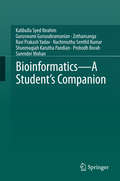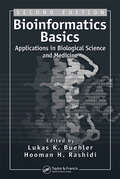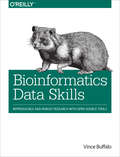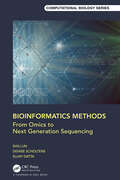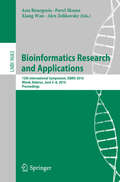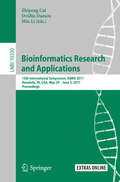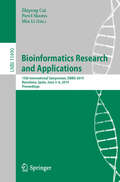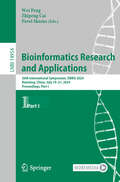- Table View
- List View
Bio-Inspired Computing: 18th International Conference, BIC-TA 2023, Changsha, China, December 15–17, 2023, Revised Selected Papers, Part II (Communications in Computer and Information Science #2062)
by Yong Wang Linqiang Pan Jianqing LinThe two-volume set CCIS 2061 and 2062 constitutes the refereed post-conference proceedings of the 18th International Conference on Bio-Inspired Computing: Theories and Applications, BIC-TA 2023, held in Changsha, China, during December 15–17, 2023.The 64 revised full papers presented in these proceedings were carefully reviewed and selected from 168 submissions. The papers are organized in the following topical sections: Volume I: Evolutionary Computation and Swarm Intelligence; and Membrane Computing and DNA ComputingVolume II: Machine Learning and Applications; and Intelligent Control and Application.
Bio-Inspired Computing: 19th International Conference, BIC-TA 2024, Suzhou, China, December 20–22, 2024, Revised Selected Papers, Part I (Communications in Computer and Information Science #2530)
by Tingfang Wu Linqiang Pan Jianqing LinThe two-volume set CCIS 2530 and 2531 constitutes the refereed post-conference proceedings of the 19th International Conference on Bio-Inspired Computing: Theories and Applications, BIC-TA 2024, held in Suzhou, China, during December 20–22, 2024. The 41 full papers presented in these proceedings were carefully reviewed and selected from 139 submissions. The papers are organized in the following topical sections: Neural Computing, Evolutionary Computation, Bio-inspired Computing, and Applications.
Bio-Inspired Computing: 19th International Conference, BIC-TA 2024, Suzhou, China, December 20–22, 2024, Revised Selected Papers, Part II (Communications in Computer and Information Science #2531)
by Tingfang Wu Linqiang Pan Jianqing LinThe two-volume set CCIS 2530 and 2531 constitutes the refereed post-conference proceedings of the 19th International Conference on Bio-Inspired Computing: Theories and Applications, BIC-TA 2024, held in Suzhou, China, during December 20–22, 2024. The 41 full papers presented in these proceedings were carefully reviewed and selected from 139 submissions. The papers are organized in the following topical sections: Neural Computing, Evolutionary Computation, Bio-inspired Computing, and Applications.
Bio-Mimetic Swimmers in Incompressible Fluids: Modeling, Well-Posedness, and Controllability (Advances in Mathematical Fluid Mechanics)
by Alexander KhapalovThis monograph presents an original, concise mathematical theory for bio-mimetic swimmers in the framework of a coupled system of PDEs and ODEs. The authoritative research pioneered by the author serves as the basis for the method adopted here. This unique methodology consists of an original modelling approach, well-posedness results for the proposed models for swimmers, and a controllability theory that studies the steering potential of the proposed swimmers. A combination of this sort does not currently exist in the literature, making this an indispensable resource. Structured in five parts, the author establishes the main modeling approach in Part One. Part Two then presents the well-posedness results for these models. Parts Three through Five serve to develop a controllability theory for the swimmers, which are conceived of as artificial mechanical devices that imitate the swimming motion of fish, eels, frogs, and other aquatic creatures in nature. Several illustrative examples are provided in the last portion that serve as potential research topics. Bio-Mimetic Swimmers in Incompressible Fluids will appeal to graduate students and researchers studying fluid dynamics and control theory, as well as engineers interested in these areas.
Bio-inspired Information and Communications Technologies: 15th EAI International Conference, BICT 2024, Quzhou, China, August 15–16, 2024, Proceedings (Lecture Notes of the Institute for Computer Sciences, Social Informatics and Telecommunications Engineering #592)
by Kun Yang Yue Sun Yifan ChenThis book constitutes the refereed proceedings of the 15th EAI International Conference on Bio-inspired Information and Communications Technologies, BICT 2024, held in Quzhou, China, during August 15–16, 2024. The 16 full papers included in this book were carefully reviewed and selected from 52 submissions. They were organized in topical sections as follows: Asia-Pacific Workshop on Molecular Communications; Bio-inspired ICT; and ICT-inspired Biomedicine.
Bio-inspired Neurocomputing (Studies in Computational Intelligence #903)
by Akash Kumar Bhoi Valentina E. Balas Pradeep Kumar Mallick Chuan-Ming LiuThis book covers the latest technological advances in neuro-computational intelligence in biological processes where the primary focus is on biologically inspired neuro-computational techniques. The theoretical and practical aspects of biomedical neural computing, brain-inspired computing, bio-computational models, artificial intelligence (AI) and machine learning (ML) approaches in biomedical data analytics are covered along with their qualitative and quantitative features. The contents cover numerous computational applications, methodologies and emerging challenges in the field of bio-soft computing and bio-signal processing. The authors have taken meticulous care in describing the fundamental concepts, identifying the research gap and highlighting the problems with the strategical computational approaches to address the ongoing challenges in bio-inspired models and algorithms. Given the range of topics covered, this book can be a valuable resource for students, researchers as well as practitioners interested in the rapidly evolving field of neurocomputing and biomedical data analytics.
Bio-mathematics, Statistics, and Nano-Technologies: Mosquito Control Strategies
by Peyman GhaffariFinding effective methods for mosquito control remains one of the great global challenges facing this generation. Bio-mathematics, Statistics and Nano-Technologies: Mosquito Control Strategies brings together experts from a large array of disciplines in order to provide a comprehensive overview of cutting-edge techniques to model, analyse and combat mosquito-transmitted vector-borne diseases. Features Includes multiple case studies Suitable for scientists and professionals working on methods for mosquito control and Epidemiology Provide a much-needed focal point for interdisciplinary discussion
BioMedical Visualization: Past Work, Current Trends, and Open Challenges (Synthesis Lectures on Visualization)
by Bernhard Preim Katarína Furmanová Barbora Kozlíková Thomas Höllt M. Eduard Gröller Renata Georgia RaidouThis book provides an overview of the many visualization strategies that have been proposed in recent decades for solving problems within the disciplines of medicine and biology. It also evaluates which visualization techniques applied to various areas of biomedicine have been the most impactful and which challenges can be considered solved using visualization. The topics covered in this book include visualization research in omics, interaction networks and pathways, biological structures, tumor diagnosis and treatment, vasculature, brain, surgery, educational contexts, therapy and rehabilitation, electronic health records, and public health. One chapter is dedicated to general visualization techniques commonly used for biomedical data, such as surface and volume rendering, as well as abstract and illustrative approaches. For each of these areas, the past and present research trends are discussed, highlighting the influential works. Furthermore, the book explains how research is affected by developments in technology, data availability, and domain practice. Individual sections also summarize the typical target users, the nature of the data, and the typical tasks addressed in the given domain. With a uniquely broad scope, the book identifies research trends in biomedical visualization using a manually curated and searchable repository of more than 3,800 publications. The resultant trends are further categorized according to the application field and using natural language processing. The book also utilizes 16 interviews conducted with researchers in the field of biomedical visualization for the purpose of soliciting their opinions regarding the evolution and trends in the domain. The book handles these topics in a concise manner to help readers orient themselves in the already mature and diverse field of biomedical visualization without overwhelming them with technical details. As such, the book can help young researchers to become familiar with past challenges and identify future ones. For more senior researchers, it can serve as an insightful overview of the research field and the direction in which it is heading.
Bioaerosol Characterisation, Transportation and Transmission: Fundamental, Modelling and Application
by Jiyuan Tu Yihuan YanThis book aims to predict and model the transport of bioaerosols, identify their transmission characteristics, and assess occupants’ infection risks. Although existing epidemiological books provide fundamental infection rate of existing diseases, the ability of predicting emerging disease transmission in the air and assessing occupants’ infection risks to the bioaerosols is significantly lacking. This book is considered as a professional book that provides in-depth discussion of the aforementioned issues and provides potential approaches to solve these issues would be highly demanded by readers in this emerging research field. This book offers essential and systematic analysis on the fate of bioaerosols from their release in the air to the final destination in human’s respiratory systems through direct 3D visualizations techniques. It also provides quantifiable method to assess each occupant’s infection risks to the infectious bioaerosols in indoor environments. The readers will gain essential fundamental characteristics of bioaerosols (active time, viability, etc.) and will gain the advanced skills on how to integrate these properties into numerical modeling and assess the occupants’ exposure risks.
Bioassays with Arthropods
by Efren Olguin Brad Alberts Jacqueline Robertson Moneen JonesImagine a statistics book for bioassays written by a statistician. Next, imagine a statistics book for bioassays written for a layman. Bioassays with Arthropods, Third Edition offers the best of both worlds by translating the terse, precise language of the statistician into language used by the laboratory scientist. The book explains the statistical basis and analysis for each kind of quantal response bioassay in just the right amount of detail. The first two editions were a great reference for designing, conducting, and interpreting bioassays: this completely revised and updated third edition will also train the laboratory scientist to be an expert in estimation of dose response curves. New in the Third Edition: Introduces four new Windows and Apple-based computer programs (PoloJR, OptiDose, PoloMixture and PoloMulti) for the analyses of binary and multiple response analyses, respectively Replaces out-of-date GLIM examples with R program samples Includes a new chapter, Population Toxicology, and takes a systems approach to bioassays Expands the coverage of invasive species and quarantine statistics Building on the foundation set by the much-cited first two editions, the authors clearly delineate applications and ideas that are exceptionally challenging for those not already familiar with their use. They lead you through the methods with such ease and organization, that you suddenly find yourself readily able to apply concepts that you never thought you would understand. To order the PoloSuite computer software described in Bioassays with Arthropods, Third Edition, use the order form found at www.leora-software.com or contact the LeOra Software Company at leorasoftware@gmail.com.
Biochemistry of Women Methods: For Clinical Investigation
by A.S. CurryThis book is written by experts who, using the latest techniques, describe laboratory investigations into women from conception to the grave. We asked the authors tp pay particular attention to the interpretation of laboratory results so we hope the book will be of interest to clinicians as well as to medical scientists.
Biocoating for Fertilizer Industry (SpringerBriefs in Applied Sciences and Technology)
by Husnul Azan Tajarudin Charles Wai NgThis book presents the advancement of coating materials technology especially in agriculture, particularly for fertilizers. Fertilizers are a critical component in meeting rising demands and ensuring global food security. A new generation of fertilizers made by coating granules with biopolymers address these issues. Coating in agriculture is an important area in research for a more sustainable future. Many examples and instances from existing research and related research gaps are discussed. It includes applications of composites as fertilizer’s coating, advantages and disadvantages of fertilizer coating from composites, applications of bacteria in composite, applications of bacteria in fertilizer industry as well as the common techniques of coating fertilizers with drying process.
Bioequivalence and Statistics in Clinical Pharmacology (Chapman & Hall/CRC Biostatistics Series)
by Scott D. Patterson Byron JonesMaintaining a practical perspective, Bioequivalence and Statistics in Clinical Pharmacology, Second Edition explores statistics used in day-to-day clinical pharmacology work. The book is a starting point for those involved in such research and covers the methods needed to design, analyze, and interpret bioequivalence trials; explores when, how, and why these studies are performed as part of drug development; and demonstrates the methods using real world examples. Drawing on knowledge gained directly from working in the pharmaceutical industry, the authors set the stage by describing the general role of statistics. Once the foundation of clinical pharmacology drug development, regulatory applications, and the design and analysis of bioequivalence trials are established, including recent regulatory changes in design and analysis and in particular sample-size adaptation, they move on to related topics in clinical pharmacology involving the use of cross-over designs. These include, but are not limited to, safety studies in Phase I, dose-response trials, drug interaction trials, food-effect and combination trials, QTc and other pharmacodynamic equivalence trials, proof-of-concept trials, dose-proportionality trials, and vaccines trials. This second edition addresses several recent developments in the field, including new chapters on adaptive bioequivalence studies, scaled average bioequivalence testing, and vaccine trials. Purposefully designed to be instantly applicable, Bioequivalence and Statistics in Clinical Pharmacology, Second Edition provides examples of SAS and R code so that the analyses described can be immediately implemented. The authors have made extensive use of the proc mixed procedures available in SAS.
Biofuel Production, Performance, and Emission Optimization: A Comprehensive Approach to Modelling and Optimization (Springer Optimization and Its Applications #215)
by Jagadish Manjunath Patel G. C. Ajith B. S. Arun Kumar Shettigar Olusegun David SamuelThis book explores the urgent quest for sustainable energy solutions by examining potential renewable energy sources that meet global demands. As fossil fuels deplete at an alarming rate, this book addresses the critical challenges in selecting sustainable feedstocks and optimizing processes for industrial-scale biodiesel production. With a focus on Garcinia-gummi-gutta seeds as a promising feedstock, the book provides a detailed analysis of oil extraction, biofuel conversion, and the practical application of biodiesel in diesel engines. Key concepts explored include selecting and optimizing transesterification variables, engine performance, and emission characteristics. The authors employ cutting-edge tools such as statistical design of experiments and artificial intelligence to offer insights into biodiesel production's physics, kinetics, and mechanics. Readers will discover experimental results, intelligent modeling techniques, and optimization strategies that enhance biodiesel yield and engine efficiency while minimizing emissions. This resource is designed for engineers and researchers in renewable energy and biofuel production. It offers a systematic framework from feedstock selection to engine optimization, making it invaluable for those seeking to advance their knowledge in sustainable energy solutions. Whether you're a novice or a seasoned professional, this book provides the tools and insights needed to drive innovation in biodiesel production at an industrial scale.
Biogeography-Based Optimization: Algorithms and Applications
by Yujun Zheng Xueqin Lu Minxia Zhang Shengyong ChenThis book introduces readers to the background, general framework, main operators, and other basic characteristics of biogeography-based optimization (BBO), which is an emerging branch of bio-inspired computation. In particular, the book presents the authors’ recent work on improved variants of BBO, hybridization of BBO with other algorithms, and the application of BBO to a variety of domains including transportation, image processing, and neural network learning. The content will help to advance research into and application of not only BBO but also the whole field of bio-inspired computation. The algorithms and applications are organized in a step-by-step manner and clearly described with the help of pseudo-codes and flowcharts. The readers will learn not only the basic concepts of BBO but also how to apply and adapt the algorithms to the engineering optimization problems they actually encounter.
Biographical Encyclopedia of Scientists
by John DaintithNew Edition of a Highly Regarded Reference As the first fully updated version in almost a decade, this comprehensive compendium brings together 2400 scientists who have made important contributions to the wide world of science. Rather than a Who's-Who style laundry list, this user-friendly resource provides essential biographical information and fo
Bioinformatic and Statistical Analysis of Microbiome Data: From Raw Sequences to Advanced Modeling with QIIME 2 and R
by Jun Sun Yinglin XiaThis unique book addresses the bioinformatic and statistical modelling and also the analysis of microbiome data using cutting-edge QIIME 2 and R software. It covers core analysis topics in both bioinformatics and statistics, which provides a complete workflow for microbiome data analysis: from raw sequencing reads to community analysis and statistical hypothesis testing. It includes real-world data from the authors’ research and from the public domain, and discusses the implementation of QIIME 2 and R for data analysis step-by-step. The data as well as QIIME 2 and R computer programs are publicly available, allowing readers to replicate the model development and data analysis presented in each chapter so that these new methods can be readily applied in their own research. Bioinformatic and Statistical Analysis of Microbiome Data is an ideal book for advanced graduate students and researchers in the clinical, biomedical, agricultural, and environmental fields, as well as those studying bioinformatics, statistics, and big data analysis.
Bioinformatics - A Student's Companion
by Kalibulla Syed Ibrahim Guruswami Gurusubramanian Zothansanga Ravi Prakash Yadav Nachimuthu Senthil Kumar Shunmugiah Karutha Pandian Probodh Borah Surender MohanThis manual offers a stand-alone reading companion, unique in simplifying the practical components of Bioinformatics in a unique and user-friendly manner. It covers the practical component of syllabi used at most leading universities and discusses the most extensively used tools and methodologies in Bioinformatics. Research in the biological sciences has made tremendous strides in recent years due in part to the increased automation in data generation. At the same time, storing, managing and interpreting huge volumes of data has become one of the most challenging tasks for scientists. These two aspects have ultimately necessitated the application of computers, giving rise to a highly interdisciplinary discipline-Bioinformatics. Despite the richness of bioinformatics resources and methods, the exposure of life sciences undergraduates and postgraduates to bioinformatics is extremely limited. Though the internet offers various tools for free, and provides guides for using them, it fails to help users interpret the processed data. Moreover, most sites fail to update their help pages to accommodate software upgrades. Though the market is flooded with books discussing the theoretical concepts in Bioinformatics, a manual of this kind is rarely found. The content developed to meet the needs of readers from diverse background and to incorporate the syllabi of undergraduate and postgraduate courses at various universities.
Bioinformatics Basics: Applications in Biological Science and Medicine
by Lukas K. Buehler Hooman H. RashidiEvery researcher in genomics and proteomics now has access to public domain databases containing literally billions of data entries. However, without the right analytical tools, and an understanding of the biological significance of the data, cataloging and interpreting the molecular evolutionary processes buried in those databases is difficult, if
Bioinformatics Data Skills
by Vince BuffaloLearn the data skills necessary for turning large sequencing datasets into reproducible and robust biological findings. With this practical guide, you'll learn how to use freely available open source tools to extract meaning from large complex biological data sets.At no other point in human history has our ability to understand life's complexities been so dependent on our skills to work with and analyze data. This intermediate-level book teaches the general computational and data skills you need to analyze biological data. If you have experience with a scripting language like Python, you're ready to get started.Go from handling small problems with messy scripts to tackling large problems with clever methods and toolsProcess bioinformatics data with powerful Unix pipelines and data toolsLearn how to use exploratory data analysis techniques in the R languageUse efficient methods to work with genomic range data and range operationsWork with common genomics data file formats like FASTA, FASTQ, SAM, and BAMManage your bioinformatics project with the Git version control systemTackle tedious data processing tasks with with Bash scripts and Makefiles
Bioinformatics Methods: From Omics to Next Generation Sequencing (Chapman & Hall/CRC Computational Biology Series)
by Sujay Datta Shili Lin Denise ScholtensThe past three decades have witnessed an explosion of what is now referred to as high-dimensional `omics' data. Bioinformatics Methods: From Omics to Next Generation Sequencing describes the statistical methods and analytic frameworks that are best equipped to interpret these complex data and how they apply to health-related research. Covering the technologies that generate data, subtleties of various data types, and statistical underpinnings of methods, this book identifies a suite of potential analytic tools, and highlights commonalities among statistical methods that have been developed. An ideal reference for biostatisticians and data analysts that work in collaboration with scientists and clinical investigators looking to ensure rigorous application of available methodologies. Key Features: Survey of a variety of omics data types and their unique features Summary of statistical underpinnings for widely used omics data analysis methods Description of software resources for performing omics data analyses
Bioinformatics Research and Applications: 12th International Symposium, ISBRA 2016, Minsk, Belarus, June 5-8, 2016, Proceedings (Lecture Notes in Computer Science #9683)
by Anu Bourgeois Pavel Skums Xiang Wan Alex ZelikovskyThis book constitutes the proceedings of the 12th International Symposium on Bioinformatics Research and Applications, ISBRA 2016, held in Minsk, Belarus, in June 2016. The 25 papers presented in this volume were carefully reviewed and selected from 77 submissions. They were organized in topical sections named: next generation sequencing data analysis; protein-protein interactions and networks; protein and RNA structure; phylogenetics; sequence analysis; and statistical methods.
Bioinformatics Research and Applications: 13th International Symposium, ISBRA 2017, Honolulu, HI, USA, May 29 – June 2, 2017, Proceedings (Lecture Notes in Computer Science #10330)
by Zhipeng Cai, Ovidiu Daescu and Min LiThis book constitutes the proceedings of the 13th International Symposium on Bioinformatics Research and Applications, ISBRA 2017, held in Honolulu, HI, USA, in May/June 2017. The 27 full papers presented together with 18 short papers and 24 invited abstracts were carefully reviewed and selected from 131 submissions. They cover topics such as: biomarker discovery; biomedical databases and data integration; biomedical text mining and ortologies; biomolecular imaging; comparative genomics; computational genetic epidemiology; computational proteomics; data mining and visualization; gene expression analysis; genome analysis; high-performance bio-computing; metagenomics; molecular evolution; molecular modelling and simulation; next-generation sequencing data analysis; pattern discovery and classification; population genetics; software tools and applications; structural biology; and systems biology.
Bioinformatics Research and Applications: 15th International Symposium, ISBRA 2019, Barcelona, Spain, June 3–6, 2019, Proceedings (Lecture Notes in Computer Science #11490)
by Min Li Pavel Skums Zhipeng CaiThis book constitutes the proceedings of the 15th International Symposium on Bioinformatics Research and Applications, ISBRA 2019, held in Barcelona, Spain, in June 2019. The 22 full papers presented in this book were carefully reviewed and selected from 95 submissions. They were organized in topical sections named: genome analysis; systems biology; computational proteomics; machine and deep learning; and data analysis and methodology.
Bioinformatics Research and Applications: 20th International Symposium, ISBRA 2024, Kunming, China, July 19–21, 2024, Proceedings, Part I (Lecture Notes in Computer Science #14954)
by Pavel Skums Zhipeng Cai Wei PengThis book constitutes the refereed proceedings of the 20th International Symposium on Bioinformatics Research and Applications, ISBRA 2024, held in Kunming, China, in July 19–21, 2024. The 93 full papers included in this book were carefully reviewed and selected from 236 submissions. The symposium provides a forum for the exchange of ideas and results among researchers, developers, and practitioners working on all aspects of bioinformatics and computational biology and their applications.
